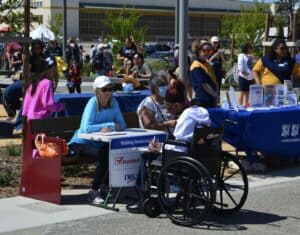Ranked Choice Voting (RCV) gathered steam in the 2022 election. From statewide to county and city races, the voting method of ranking candidates by preference was adopted by voters in eight more places. Hundreds of thousands of voters across America, including the Bay Area, are already using it. In Alameda, ranked choice voting was a topic of discussion at candidate forums and in written questionnaires.

“RCV is on a clear path to becoming the norm, not the exception,” said FairVote.org Director of Research Deb Otis. “In large parts of the country, voting equals ranking.”
Why choose Ranked Choice Voting?
This voting method would upgrade the way Alamedans vote. With RCV, candidates need to receive a majority of votes cast in order to win. Now, whoever gets the most votes wins even if it is not a majority.
In November, neither City Council winner reached the 33.34 percent majority threshold needed when two seats are being contested. That’s the threshold in a two-seat race because it is mathematically impossible for a third candidate to also reach it. Tony Daysog got 27.95 percent of the votes, Tracy Jensen got 19.54 percent, and the other candidates split the remaining 52.51 percent.
The top two vote-getters may well have been the same if RCV had been used. That is often the case, but not always, as we saw in the recent Oakland mayoral race. The important goal of RCV is that the winner is supported by a majority of the voters and thus has a clear mandate to govern. We will never know who the majority supported in our recent City Council election.
How it works
Ranked Choice Voting is simple. Instead of voting for one candidate for each seat, voters can opt to rank candidates in order of preference. If no candidate reaches the majority threshold, then an instant runoff takes place by using voters’ backup choices. The candidate in last place is eliminated, and the next choice of those who chose the eliminated candidate is reallocated and tallied. That process repeats until someone wins a majority of votes.
League of Women Voters of Alameda support RCV

The League of Women Voters of Alameda (LWVA) and their supporters want the option to institute RCV in Alameda to appear on the ballot in 2024. The League has been explaining the voting method to interested groups and organizations, as well as tabling at public events, so the local electorate will be informed should the option make it to the ballot.
While the wind is at the League’s back, electoral reform is difficult to pass. People are reluctant to change, especially those who win under the current system. Thus, it is unlikely that the City Council will put RCV on the ballot. Instead, a citizens’ initiative, which requires collecting signatures to get a measure on the ballot, will be needed.
“I don’t understand what’s the big deal,” said one gentleman visiting a LWVA table. “Ireland and Australia have been using it for ages, but there it’s called preferential voting.”
RCV across the US
Ranked Choice Voting has become the fastest-growing electoral reform in the nation because it ensures elected officials have the broadest range of support, and reduces political polarization and negative campaigning. Candidates are motivated to expand their base of support by asking voters whose first choice is another candidate to consider them as their second choice. It also encourages more women and racial minorities to run for office. And it saves the expense and delay of a separate runoff election when a majority mandate is required.
This year in Alaska, for example, election results reflect how RCV fosters an independent approach to politics, with wins by Democrat Mary Peltola in the House race, moderate Republican Lisa Murkowski in the Senate race, and conservative Republican Mike Dunleavy in the Governor race. Candidates ran on their ideas rather than their adherence to political party orthodoxy. No one was told that their votes would be wasted or split. No candidate was told they would be a spoiler. Instead, everyone got to voice their true preference.
Following Alaska’s lead, Nevada approved the first of two votes needed to adopt RCV for its statewide general elections. Voters also approved it in cities in Oregon, Washington, Maine, California, Illinois, and Colorado. Voters in Albany used RCV for the first time this election season, adding racial diversity on two council seats.
Meanwhile, detractors may blame the voting method when their candidate doesn’t win, despite the eventual winner being the preference of the majority of voters.
Alamedans will ultimately choose if and when they want to upgrade their electoral system. Stay tuned as the local effort for Ranked Choice Voting forges ahead.
Contributing writer Irene Dieter’s articles are collected at alamedapost.com/Irene-Dieter, and she also posts stories on her blog I on Alameda.
Editorials and Letters to the Editor
All opinions expressed on this page are the author's alone and do not reflect those of the Alameda Post, nor does our organization endorse any views the author may present. Our objective as an independent news source is to fully reflect our community's varied opinions without giving preference to a particular viewpoint.
If you disagree with an opinion that we have published, please submit a rebuttal or differing opinion in a letter to the Editor for publication. Review our policies page for more information.




